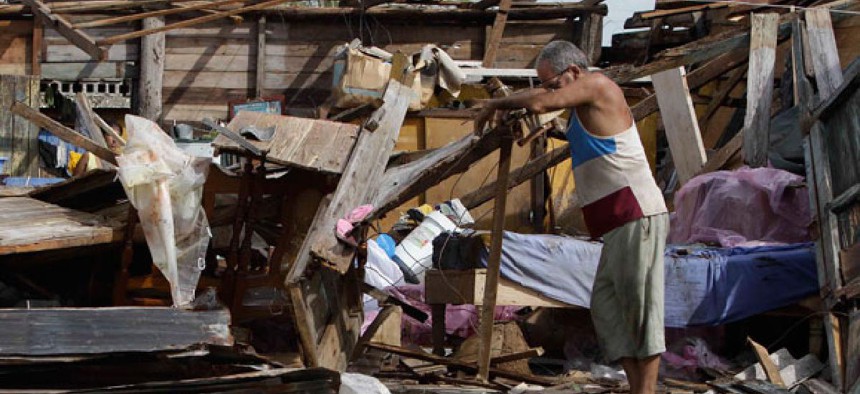
Resident Antonio Garces tries to recover his belongings from his house destroyed by Hurricane Sandy in Aguacate, Cuba, Thursday Oct. 25, 2012. Hurricane Sandy blasted across eastern Cuba on Thursday as a potent Category 2 storm and headed for the Bahamas
Hurricane Sandy: How Government Uses Social Media for Disaster Response
The government is using social media in innovative ways to get help where it's needed fast.
As Hurricane Sandy approaches, how are government agencies using social media to prepare for, respond to, and recover from disasters?
Systematic usage might include:
- "using the medium to conduct emergency communications and issue warnings";
- "using social media to receive victim requests for assistance";
- "monitoring user activities and postings to establish situational awareness"; and
- "using uploaded images to create damage estimates, among others."
In each phase, agencies are turning to a different mix of tools to help them achieve their goals. Of course, all government agencies at every level should adhere to the roles and responsibilities laid out in the National Response Framework, which lays out the responsibilities of the federal and state governments as:
- "Coordinating with private-sector and nongovernmental organizations involved in donations management and other recovery activities."
- "Establishing Disaster Recovery Centers. Federal, State, tribal, local, voluntary, and nongovernmental organizations determine the need for and location of Disaster Recovery Centers."
- "Coordinating with the private sector on restoration and recovery of CIKR [Critical Infrastructure and Key Resources]. Activities include working with owners/operators to ensure the restoration of critical services, including water, power, natural gas and petroleum, emergency communications, and healthcare."
- "Coordinating mitigation grant programs to help communities reduce the potential impacts of future disasters. Activities include developing strategies to rebuild resilient communities."
CRS's Lindsay also writes that "According to [FEMA] Administrator [Craig] Fugate, possible future applications include using smartphone-friendly mobile versions of FEMA websites to allow users to access information and request assistanceand using social media to facilitate communication between citizens, first responders, volunteer groups, the private sector, and all levels of government."
Responding Social media have dramatically changed how the government can respond in the dynamic environment of a disaster. Lindsay writes that social media can be used to:
- alert emergency managers and officials to certain situations by monitoring the flow of information from different sources during an incident;
- increase the public's ability to communicate with the government;
- [allow members of the public to communicate with one another because] information can flow in multiple directions (known as backchannel communication); and
- supplement to "911" emergency system lines.
Lindsay notes that a "study commissioned by the American Red Cross, younger people generally use social media more frequently than older segments of society. They are also more likely to request help through social media, believe agencies should monitor their postings, and have high expectations that agencies will respond quickly to their requests"
Recovering Social media has yet to play a major role in recovery efforts, Lindsay writes, but he also notes that "if FEMA adopted social media use for recovery, the agency could provide information concerning what types of individual assistance is available to individuals and households, including how to apply for assistance, announcing application deadlines and providing information and links to other agencies and organizations that provide recovery assistance, such as the American Red Cross, or Small Business Administration (SBA) disaster loans for homes and businesses."
The federal government's role in recovery, however, is usually circumscribed, and consists largely of coordinating and facilitating activities of local governments, nonprofits, and private-sector organizations, as noted in the excerpts from the National Response Framework (NRF), above.
There are groups that have robust social media tools to aid in recovery. One example is Hands-on-network, which, according to its Web site, "inspires, equips and mobilizes people to take action. . . ." The site offers visitors the ability to "start a project," which other people may then join.
In a slightly different vein, the National Voluntary Organizations Active in Disaster (National VOAD) describes itself as a "forum where organizations share knowledge and resources throughout the disaster cycle-preparation, response and recovery-to help disaster survivors and their communities." Their Web site features a map where people who are interested in volunteering can find local coordination centers all across the US.
Additionally, many other organizations allow people to assist government agencies both in routine maintenance and disaster recovery. An example is SeeClickFix, which some government agencies used to collect information about the damage from Hurricane Irene. The site ran a pilot program through which citizens could not only report issues, but to self-organize to address them directly.
As part of their coordination responsibilities, government agencies could partner with groups like these during disaster recovery activities.
Platforms
Perhaps the strongest case for using social media for disaster planning, response, and recovery, however, is that it is available even in the midst of almost any kind of event. Through home computers, people far from an event can keep track of the details and the latest information, and through mobile technologies, people affected by an event can communicate with first responders, each other, and their extended networks beyond the event's perimeter.







